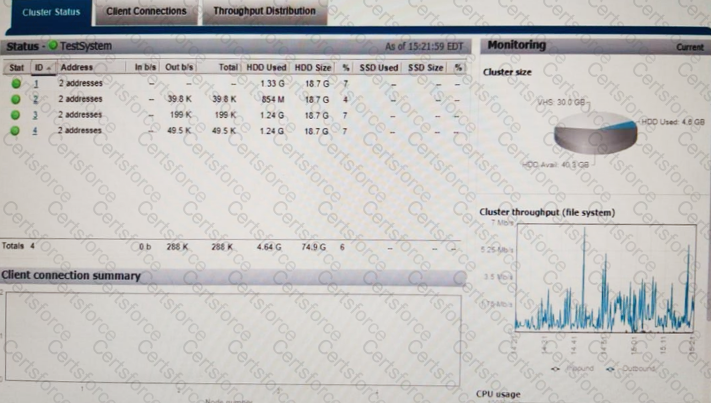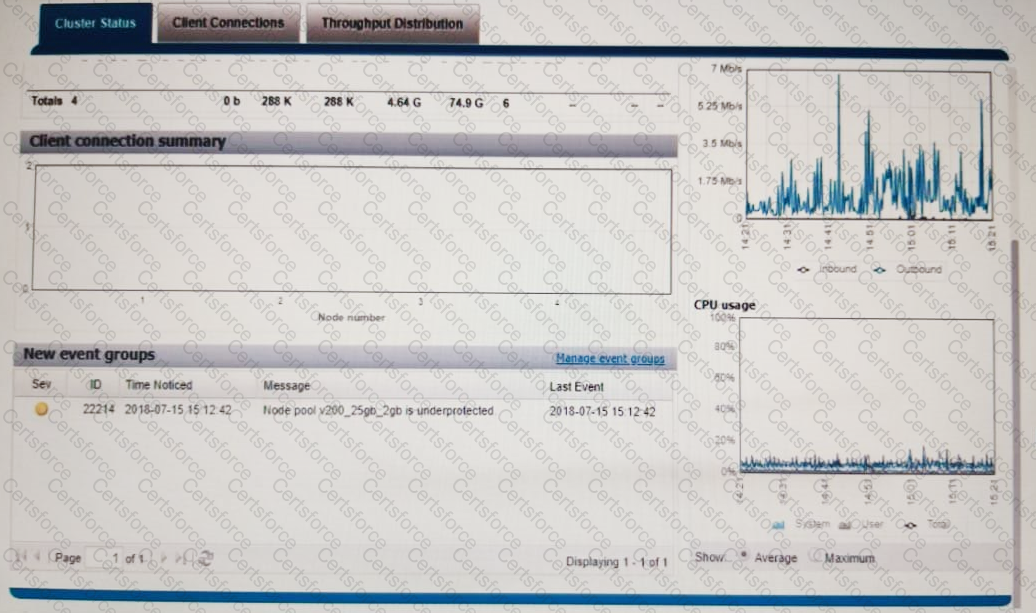A company has two Dell EMC Isilon clusters. The source cluster is running OneFS 8.0.x and the target cluster is running OneFS 7.2.x with replication policies configured from the source to the target cluster. OneFS will not be upgraded on the target cluster.
After some time, the company decided to archive some of the data to ECS using CloudPools. One of the company’s concerns is how the archived data will be replicated using the existing SyncIQ policies. What is recommended approach to address the company’s concerns?
SyncIQ policies are being configured between two Dell EMC Isilon clusters at a company’s location. In addition, the company wants the ability to perform a failover at an Access zone level. Which actions should be performed to meet the requirement?
A company’s HPC environment is using Dell EMC Isilon Gen 6 nodes. They have additional throughput requirements and have asked for your recommendations. The environment consists of two subnets:
Mgmt-subnet: 1x1-GigE interface in the “mgmt-pool” for management traffic on a VLAN-tagged management network in an Isilon default System Access zone.
Data-subnet: 2x10-GigE aggregated interfaces in the “data-pool” for data traffic on a VLAN-tagged data network in an Isilon user-defined data Access Zone
Which recommendation should be provided?
A media company has a Microsoft Windows-based infrastructure and uses Adobe media editing tools to create advertisements for its customers. Users from the Media Production department store all types of media files on a Dell EMC Isilon cluster.
In addition, users from the Support department are not allowed to store MP3 and AVI files to the NAS system. Both the Media Production and Support departments need to acces other common data on the cluster. Due to workflow procedures, the media files are stored on the same path on the Isilon cluster.
The company wants to know which Isilon features are available and can restrict the Support department users from writing certain media file types onto the Isilon cluster. Which recommendation should be provided?
A company has a medical application that generates a large number of media files. The file count is well over one billion and is stored on a Dell EMC Isilon 8-node NL410 cluster. Currently, each node is connected to the network using two 10GbE connections. The Linux-based application does not require high bandwidth; however, it is latency sensitive. Additionally, the Linux hosts are connected to the cluster over NFSv3. The application generates approximately 10,000 files every 10 minutes.
For the past four years, the cluster has been growing at a rate of one additional node per year. The company is running out of free ports on their redundant network switches. They want to know what can be done to ensure continuous availability. They do not want to invest in upgrading the network infrastructure. In addition, the company needs to reduce the number of consumed interface ports on the switches.
Which recommendation should be provided?
A company has purchased a new Dell EMC Isilon cluster as a disaster recovery solution and plans to use SyncIQ. SBR is not currently enabled. The systems administrator has asked for advice about how to configure the network connectivity for the replication traffic.
What are Dell EMC recommendations for a replication network configuration?
A Dell EMC Isilon administrator has reported that in Access zone “ProdZone” on the OneFS file system “nfs1”, Microsoft Windows “DEES\user1” has root level permission on nfs1. Use the “Launch Situation” button to examine the environment and validate the reason for this condition. Note: It is necessary to “close” (x) the simulation windows to answer the question.
Based on your findings, what is the reason for the condition?


A company has a Dell EMC Isilon cluster that will be used for a large amount of client requests. SmartConnect has been configured to help load balance the clients across the cluster. How does SmartConnect help the load balancing?
An administrator is investigating the performance of one of their Dell EMC Isilon clusters. Using the isi statistics drive command, the performance of the first five drives is shown.
Based on the exhibit, what represents the status of the drives?

A company uses the Dell EMC Isilon cluster’s A200 nodes for short-team archiving of digitized film. Historical and trending information shows that the cluster capacity will reach 90% full in 60 days. To avoid the need to purchase additional A200 nodes, the company requires a solution that archives data not accessed for 18 months to a more cost-effective platform. The long-term archive data must be online and accessible. Some performance loss is acceptable.
Which IT strategy provides a long-term solution that meets the requirements?